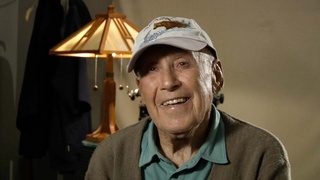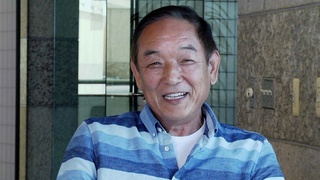Interviews
Choice to move east or go to Japan
The government said, I think United States and Canada knows Japan's gonna be... so before that, if you want to stay in Canada, move to east. Unless if you're gonna go Japan, you stay in Tashme. So the family in Tashme, we're the one family moved east. We're the first one, because when we moved, that day, it was a German was... so we were scared if a soldier saw us in the train, what... so Bob said, Just keep quiet, what they say everything, just keep quiet. Don't talk to them. But they didn't bother us. You know, they think we're Indian or something. [Laughs]
I*: How, how was the decision, because you could go to, I mean, the government will pay you to go to Japan, or move east. There was, how was that decision made?
Oh, yes, my father-in-law wants to go back to Japan. Of course, he was the oldest in the family, but I thought the younger one -- of course Miyoko speak Japanese and English both. But the others doesn't know how to speak Japanese. So I said, How could you take these girls to Japan? Well, good thing we didn't. Afterwards, we heard that they haven't got enough food, even the oldest family, my father-in-law was. You know, we haven't got the money. If you have lots of money to take to Japan is a different story. But those days, who got it, that kind of money? Especially we have to evacuate from their hometown and everything. So well, good thing we moved.
* "I" indicates an interviewer (Peter Wakayama).
Date: February 14, 2005
Location: Toronto, Canada
Interviewer: Peter Wakayama
Contributed by: Sedai, the Japanese Canadian Legacy Project, Japanese Canadian Cultural Center
Explore More Videos

Marriage and Returning to US
(1916 - 2013) Member of the U.S. Military Intelligence Service

Feeling prejudice while looking for jobs
(1919 - 2015) Nisei who served in World War II with the 442nd Regimental Combat Team

Generosity of the Italians
(1919 - 2015) Nisei who served in World War II with the 442nd Regimental Combat Team

Invited to teach at Harvard by his boss
(1919 - 2015) Nisei who served in World War II with the 442nd Regimental Combat Team



The riot in Manzanar
(b. 1921) Nisei veteran who served in the occupation of Japan

The Dopey bank that survived the war
(b. 1934) Award-winning Disney animation artist who was incarcerated at Topaz during WWII

My daughter couldn’t fit in Japan, so I decided to go back to America (Japanese)
(b. 1936) Shin-issei welding business owner

Evacuated to the Jungle
(b. 1938) Philipines-born hikiagesha who later migrated to the United States.

Captured by Guerillas after bombing of Pearl Harbor
(b. 1938) Philipines-born hikiagesha who later migrated to the United States.

Grandfather picked up by US Army
(b. 1952) Former banking executive, born in Hawaii

Tough life at boarding house (Japanese)
Shin Issei – owner of izakaya (Japanese-style tavern) and kappo (small Japanese diner) restaurant, Honda-Ya


Father's business partner operated their farming business during WWII
(b. 1935) Sansei businessman.
